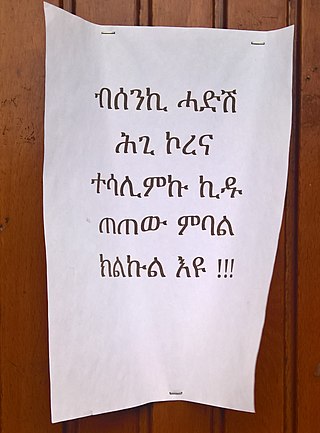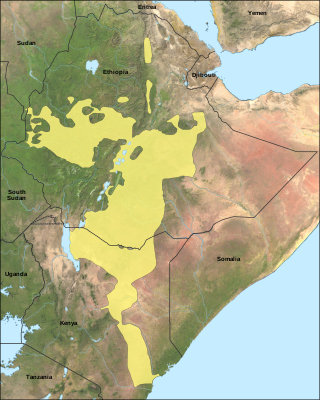Related Research Articles

The Afroasiatic languages, also known as Hamito-Semitic or Semito-Hamitic, are a language family of about 400 languages spoken predominantly in West Asia, North Africa, the Horn of Africa, and parts of the Sahara and Sahel. Over 500 million people are native speakers of an Afroasiatic language, constituting the fourth-largest language family after Indo-European, Sino-Tibetan, and Niger–Congo. Most linguists divide the family into six branches: Berber, Chadic, Cushitic, Egyptian, Semitic, and Omotic. The vast majority of Afroasiatic languages are considered indigenous to the African continent, including all those not belonging to the Semitic branch.

The Omotic languages are a group of languages spoken in southwestern Ethiopia, in the Omo River region and southeastern Sudan in Blue Nile State. The Geʽez script is used to write some of the Omotic languages, the Latin script for some others. They are fairly agglutinative and have complex tonal systems. The languages have around 7.9 million speakers. The group is generally classified as belonging to the Afroasiatic language family, but this is disputed by some.

Tigrinya is an Ethio-Semitic language commonly spoken in Eritrea and in northern Ethiopia's Tigray Region by the Tigrinya and Tigrayan peoples. It is also spoken by the global diaspora of these regions.

Ubykh is an extinct Northwest Caucasian language once spoken by the Ubykh people, a subgroup of Circassians who originally inhabited the eastern coast of the Black Sea before being deported en masse to the Ottoman Empire in the Circassian genocide.

Oromo, historically also called Galla, is an Afroasiatic language that belongs to the Cushitic branch. It is native to the Ethiopian state of Oromia and Northern Kenya and is spoken predominantly by the Oromo people and neighboring ethnic groups in the Horn of Africa. It is used as a lingua franca particularly in the Oromia Region and northeastern Kenya.
Mam is a Mayan language spoken by about half a million Mam people in the Guatemalan departments of Quetzaltenango, Huehuetenango, San Marcos, and Retalhuleu, and the Mexican states of Campeche and Chiapas. Thousands more make up a Mam diaspora throughout the United States and Mexico, with notable populations living in Oakland, California and Washington, D.C. The most extensive Mam grammar is Nora C. England's A grammar of Mam, a Mayan language (1983), which is based on the San Ildefonso Ixtahuacán dialect of Huehuetenango Department.
Hurrian is an extinct Hurro-Urartian language spoken by the Hurrians (Khurrites), a people who entered northern Mesopotamia around 2300 BC and had mostly vanished by 1000 BC. Hurrian was the language of the Mitanni kingdom in northern Mesopotamia and was likely spoken at least initially in Hurrian settlements in modern-day Syria.
Sidama or Sidaamu Afoo is an Afro-Asiatic language belonging to the Highland East Cushitic branch of the Cushitic family. It is spoken in parts of southern Ethiopia by the Sidama people, particularly in the densely populated Sidama National Regional State (SNRS). Sidaamu Afoo is the ethnic autonym for the language, while Sidaminya is its name in Amharic. It is not known to have any specific dialects. The word order is typically SOV. Sidaama has over 100,000 L2 speakers. The literacy rate for L1 speakers is 1%-5%, while for L2 speakers it is 20%. In terms of its writing, Sidaama used an Ethiopic script up until 1993, from which point forward it has used a Latin script.
Mursi is a Southeast Surmic language spoken by the Mursi people who live in the South Omo Zone on the eastern side of the lower Omo valley in southwest Ethiopia. The language is similar to Suri, another Southeast Surmic language spoken to the west of the Mursi language area. It is spoken by approximately 7,400 people.
Baiso or Bayso is an Afro-Asiatic, more specifically a Lowland East Cushitic language belonging to the Omo-Tana subgroup, and is spoken in Ethiopia, in the region around Lake Abaya.
Alagwa (Alaagwa’isa) is a Cushitic language spoken in Tanzania in the Dodoma region. Some Alagwa have shifted to other languages such as Sandawe.
Chara is an Afro-Asiatic language of the North Omotic variety spoken in the Southern Nations, Nationalities, and People's Region of Ethiopia by 13,000 people.
Ale is an Afro-Asiatic language spoken in southern Ethiopia in the administratively part of the "South Ethiopia Regional State" (SERS). It is part of the Dullay dialect cluster.
Gamo-Gofa-Dawro is an Omotic language of the Afroasiatic family spoken in the Dawro, Gamo Gofa and Wolayita Zones of the Southern Nations, Nationalities, and Peoples' Region in Ethiopia. Varieties are spoken by the Gamo, Gofa, Dawro; Blench (2006) and Ethnologue treat these as separate languages. Zala presumably belongs here as well. Dialects of Dawro (Kullo-Konta) are Konta and Kucha. In 1992, Alemayehu Abebe collected a word-list of 322 entries for all three related dialects.
Dizin is an Omotic language of the Afro-Asiatic language family spoken by the Dizi people, primarily in the Maji woreda of the Southern Nations, Nationalities and Peoples Region, located in southwestern Ethiopia. The 2007 census listed 33,927 speakers. A population of 17,583 was identified as monolinguals in 1994.

Tangale (Tangle) is a West Chadic language spoken in Northern region of Nigeria. The vast majority of the native speakers are found across Akko, Billiri, Kaltungo and Shongom Local Government Area of Gombe State Nigeria.

Kʼicheʼ, or Quiché, is a Mayan language spoken by the Kʼicheʼ people of the central highlands in Guatemala and Mexico. With over a million speakers, Kʼicheʼ is the second most widely-spoken language in the country, after Spanish. It is one of the most widely-spoken indigenous American languages in Mesoamerica.
Tamashek or Tamasheq is a variety of Tuareg, a Berber macro-language widely spoken by nomadic tribes across North Africa in Algeria, Mali, Niger, and Burkina Faso. Tamasheq is one of the three main varieties of Tuareg, the others being Tamajaq and Tamahaq.
Gumuz is a dialect cluster spoken along the border of Ethiopia and Sudan. It has been tentatively classified within the Nilo-Saharan family. Most Ethiopian speakers live in Kamashi Zone and Metekel Zone of the Benishangul-Gumuz Region, although a group of 1,000 reportedly live outside the town of Welkite. The Sudanese speakers live in the area east of Er Roseires, around Famaka and Fazoglo on the Blue Nile, extending north along the border. Dimmendaal et al. (2019) suspect that the poorly attested varieties spoken along the river constitute a distinct language, Kadallu.

Azeb Amha (1967) is a linguist working on the morphology and syntax of Afroasiatic languages, with a special focus on Omotic languages. A senior researcher at the African Studies Center Leiden, Azeb is co-editor of the international Journal of African Languages and Linguistics and member of the board of the Dutch Society for African Studies (NVAS).
References
- 1 2 3 4 5 Wolaitta at Ethnologue (27th ed., 2024)

- ↑ Abebe 2002
- ↑ Sarah Vaughan, "Ethnicity and Power in Ethiopia" Archived 2011-08-13 at the Wayback Machine (University of Edinburgh: Ph.D. Thesis, 2003), pp. 250-258
- ↑ "Ethiopian – Calendar Converter". www.calendar-converter.com. Retrieved 26 August 2017.
- ↑ "Good Amharic Books | Welcome!". Archived from the original on 2013-03-15. Retrieved 2013-02-03.
- ↑ "An analysis of Wolayta proverbs: Function in focus" (PDF). Retrieved 2019-09-18.
- 1 2 3 4 5 6
- ↑ Wakasa, Motomichi (2008). A Descriptive Study of the Modern Wolaytta Language Authors (PDF) (Doctoral thesis). The University of Tokyo. Archived from the original (PDF) on 2012-04-26. Retrieved 2011-12-04.